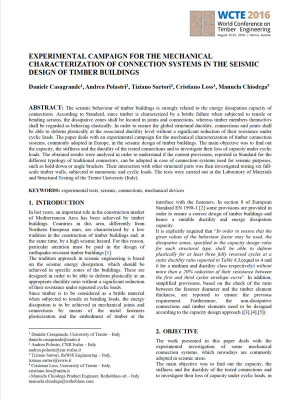
WCTE 2016 - SEISMIC REV PROJECT
The seismic behaviour of timber buildings is strongly related to the energy dissipation capacity of connections.
According to Standard, since timber is characterized by a brittle failure when subjected to tensile or bending actions, the dissipative zones shall be located in joints and connections, whereas timber members themselves shall be regarded as behaving elastically.
In order to ensure the global structural ductility, connections and joints shall be able to deform plastically at the associated ductility level without a significant reduction of their resistance under cyclic loads.
The paper deals with an experimental campaign for the mechanical characterization of timber connection systems, commonly adopted in Europe, in the seismic design of timber buildings.
The main objective was to find out the capacity, the stiffness and the ductility of the tested connections and to investigate their loss of capacity under cyclic loads.
The obtained results were analysed in order to understand if the current provisions, reported in Standard for the different typology of traditional connectors, can be adopted in case of connection systems used for seismic purposes, such as hold-down or angle brackets.
Their interaction with other structural parts was then investigated testing six fullscale timber walls, subjected to monotonic and cyclic loads.
The tests were carried out at the Laboratory of Materials and Structural Testing of the Trento University (Italy).
| WCTE 2016 - SEISMIC REV PROJECT |
|---|
